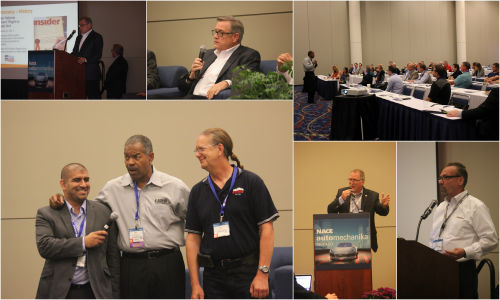By Erin McLaughlin
Chicago, Illinois — July 26, 2017 — NACE Automechanika hit the ground running this year, with the Business Outlook Conference kicking off the first day at McCormick Place West. Collision Repair magazine is the official Canadian Media Partner for NACE Automechanika.
Robert “Bob” Redding of the Automotive Service Association began the conference, with a presentation titled, “How Capitol Hill is Impacting your Business.” Over the course of the presentation, Redding illustrated key events in Washington, D.C, and outlined which of these will impact collision repair shops and distributors. Redding discussed a wide range of topics, including how federal and state governments will address connected cars and automated vehicles. While the bulk of his presentation focused on the US, it’s hard to deny that issues impacting our neighbours to the south will inevitably affect the Canadian side of the business.
Following Redding was a panel discussion on telematics and in-vehicle connectivity. The panel was moderated by Greg Potter of the Equipment and Tool Institute, with panellists Bob Stewart of General Motors, Bill Leisenring of Delphi/Control Tec, Mike Fitzgerald of Innova and Tim Morgan of Spanesi.
Each panellist addressed the audience on various issues surrounding telematics and in-vehicle connectivity. Stewart discussed General Motor’s OnStar, a strong example of how widespread these technologies have become. OnStar currently has 12 million customers in China, North America, Europe and South America, providing car owners with personalized services. The company created a partnership with IBM Watson to do this using artificial intelligence. Its features include proactive alerts, such as live-time health checks on the vehicle’s fuel levels and battery. It also allows car owners to project apps onto a screen to use them within the vehicle. “Many of our features are designed to make the customer feel more secure,” said Stewart.
Fitzgerald took to the stage next, and focused on this problem: “There are big long-term issues [in terms of dealing with telematics] that may take years to solve, so what do we do in the meantime?”
He then dove into what his company, Innova, is doing to address concerns repair shops have with telematics today. He presented the company’s plan of action, which is to work to ensure that the independent aftermarket is provided with the tools and data they need to repair today and tomorrow’s vehicles.
The solution, Fitzgerald stated, is to provide open and equal access to data while ensuring cybersecurity by attaching a telematic device to the vehicle. The device he presents is geared toward benefiting both the consumer and any eventual repairers by creating “a two-way information lane.”
Fitzgerald detailed how this would benefit both the consumer and shop owner. “The repair shop is provided a constant link to their customer, so they know exactly what’s going on. Once you do that you can collect real time customer maintenance data. The repair shop can then develop a marketing program linked to the software.”
This marketing program can include sending information to the customer regarding what kind of maintenance their vehicle needs, and when it will need it. The customer is benefited too, through access to a consumer dashboard. The car owner will get see where their vehicle is, what the duration of their trip is, and other up-close and personal information on their vehicle.
“Everyone in this room is in the collision repair industry,” said Morgan in his opening statement, suggesting that it’s critical to consider how the collision repair industry will be affected by industry moves. He delved into the importance of conducting pre-scans. “It’s imperative for a vehicle to be pre-scanned, both for the consumer and car owner,” he said. One reason for this, he explained, was, “If a customer comes to your shop and says, ‘you know, ever since I was here a part of my car doesn’t work. With a pre-scan, you can prove that to be true or false.”
Mike Jones followed the panel with a discussion revolving around self-improvement. Jones is the President and Founder of Discover Leadership Training.
“We all have a comfort zone, and we remain stuck in them even though we know there are better ways. We do this because stepping out of our comfort zone could lead to failure,” he said. “Recognize that there is still more to learn.” Jones detailed several ways in which we can strive to do this, including stepping out of our comfort zones, taking initiative for ourselves, creating a positive environment and communicating better through active listening and through communicating as clearly as possible.
Jones provided some concrete tips on how to communicate clearly by avoiding vague language, such as “My neighbour’s car is expensive,” or “That motorcycle is moving very quickly.” An expensive car to some may be $35,000. To others, it could be $100,000. Neither party’s answer would be incorrect, but it clearly demonstrates how differently people can think based on their own perceptions of the world.
“It’s incredibly important to say what you mean, because the person you’re speaking with will hear you based on not what you say, but on their own lens and filter,” said Jones.
Keep watching collisionrepairmag.com for more updates on NACE Automechanika 2017!













































































